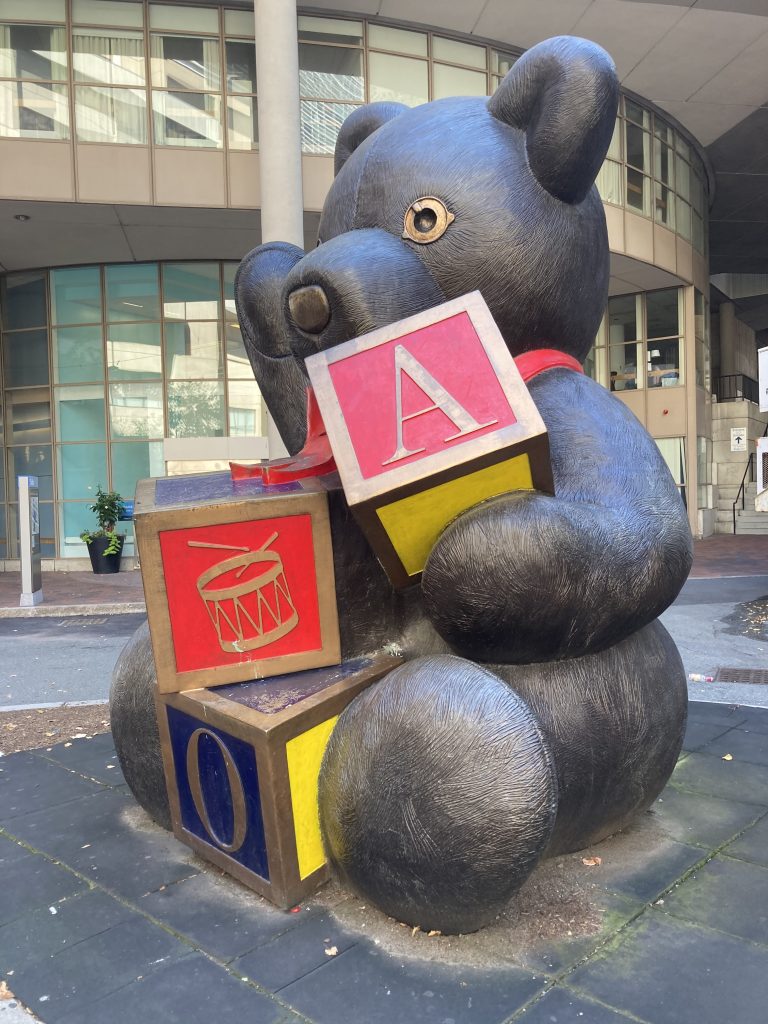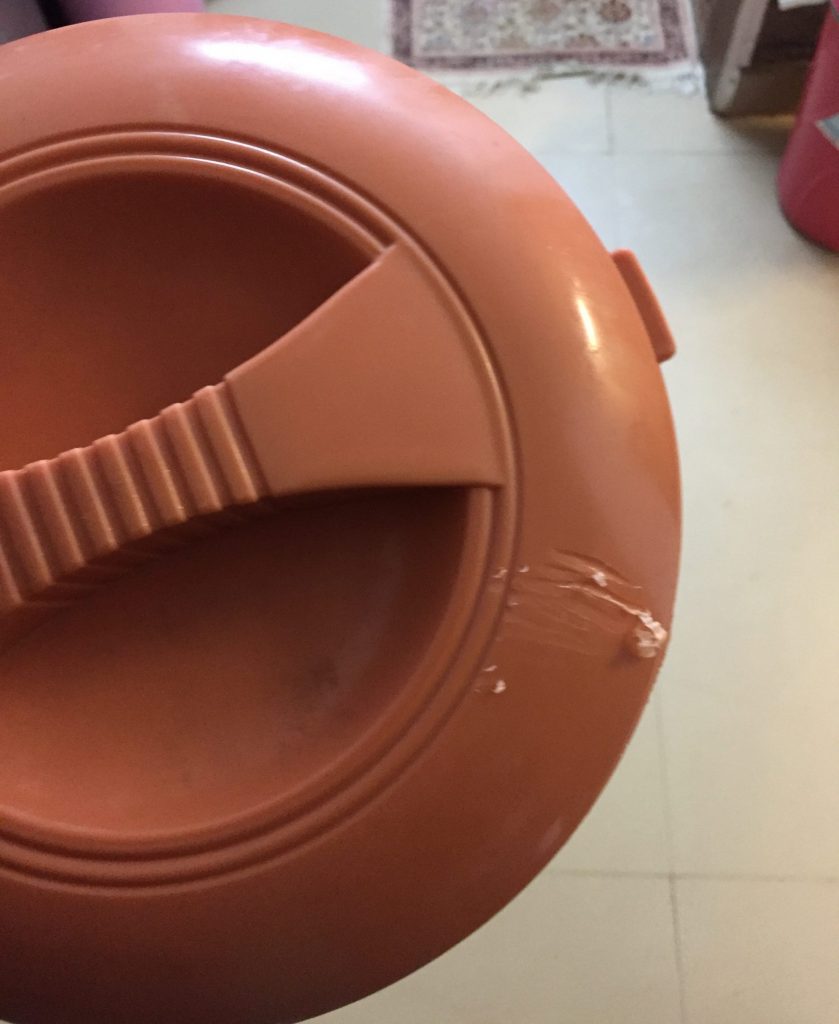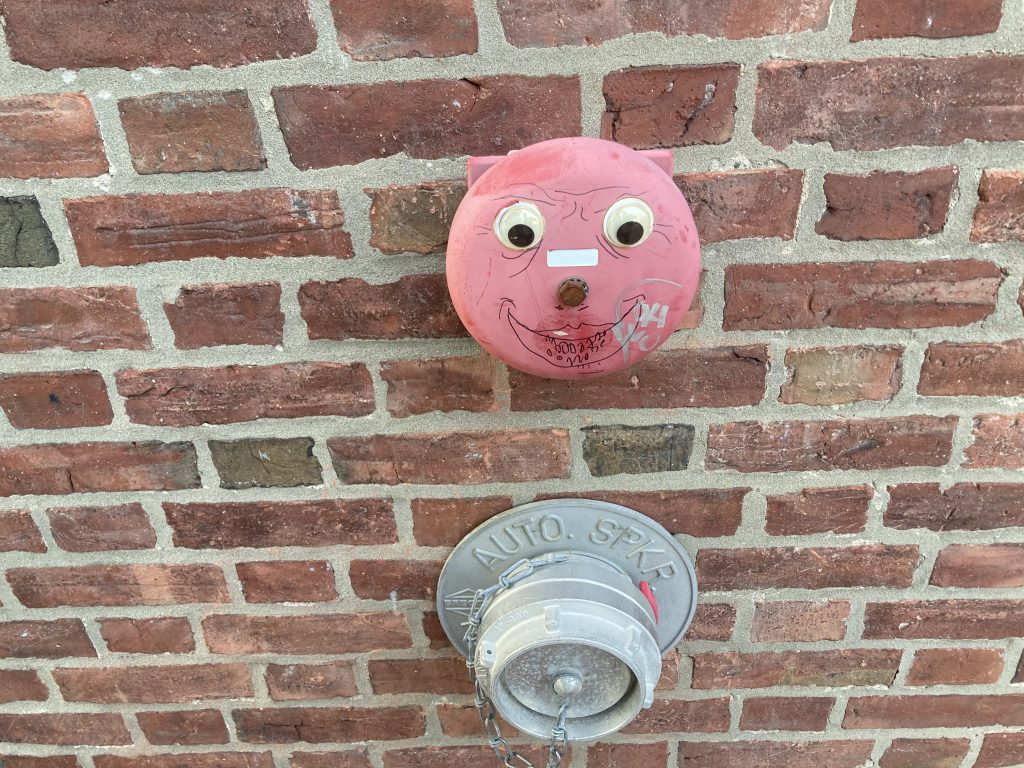food service

The traveler explores the American Wayside, verifying the contents of a mysterious guide written by a man with whom he shares a likeness and name. Excerpts from ‘Autumn by the Wayside: A Guide to America’s Shitholes’ are italicized. Traveler commentary is written in plain text.

Hector and I drive for nearly half a day, circling a behemoth construction site that turns out to be the very place we’re trying to find. The parking lot is churned mud despite the southern heat, identified by a small, temporary sign and lent structure by the sheer determination of a young man in an orange vest who kindly directs me away from the splotchy puddle topography of the inner lot to a still-firm spot on the outer-edge. I note the rain-drop applause of a small audience inside once my helmet hangs on the bars and I scoop Hector from the kennel without asking the man whether his presence will be controversial. Most people see the charred rabbit and assume he serves some unspoken purpose, to have been so afflicted and survived long enough to enter a grocery store, church, or no-pet motel. This proves to be the case at the gate- the woman there can hardly look at him. Inside, I see the facility has been cracked open like a backwards egg, the yellow exterior parting to reveal sloped, liquid-white.
‘The facility that houses ‘The New American Ice Cap’ is built to allow for constant and, optimistically, limitless expansion. Its perimeters are thick and modular, insulated with the same technology that allows humanity’s fragile shuttles to pierce the atmosphere and built on treads that permit impressive, if not fittingly-glacial, movement.
Vertical expansion, when it occurs, requires that the ‘egg’ be cracked for a great deal longer than is normal and is marked by festivities that are both extravagant and a little forced. Aside from that which is provided by the project’s sole investor, Amy Lind, these open houses are the primary source of funding for ‘The New American Ice Cap,’ raking in thousands of dollars from a population that can’t quite connect their enthusiasm for an ice park to the increasingly warm summers.
Lind is, herself, somewhat controversial in the realm of sustainability. She claims science has sided with the project, that the egg’s harnessing of solar and wind power to maintain the sub-zero acreage is nearing self-sufficiency. Most sources without connection to Lind suggest quite the opposite. Outages are increasingly common in ‘The New American Ice Cap’s’ satellite towns as the frozen mountain sucks power from the grid, purring like a contented refrigerator in the dusty alcove of an old house.’
The ‘egg’ is well-cracked by the time Hector and I pay our outrageous $30 entry pass. We’re buffeted by intermittent bursts of frigid air that rush through the gates, swelling a sign past the entry gate that describes the technological marvel that is today’s intended purpose. The event is an all-sides expansion, the culmination of years of planning and the catalyst for which is the project having closed on a strip of land over the border of Georgia that had been inhibiting growth for half a decade. Though the flower-petal walls of the egg appear to be stationary, they are, in fact, moving backward to meet the second wave that stands behind them. By the end of the day, a lid will be placed on the facility and the enclosed campus will have grown exponentially. Tickets to witness this ‘Eclipse’ are beyond my budget but will likely fund ‘The Great American Ice Cap’ for a few more years alone.
In the meantime, southerners have come out in droves to clamber about the sides of the ice mountain- to throw snowballs, sled, and nest expensive beers is even pricier snow. The entire mountain has drooped and spilled from the cracks, flooding the outskirts for miles around. Informational clips, largely ignored, claim that the saturated ground will be re-frozen by the end of the month and provide a stable foundation for the growing ice cap.
Hector shivers under my arm as we approach the base of the cap itself. It’s gargantuan despite the molted slush and the swirling pillar of vapor that has begun to form a cloud overhead. If not for the behavior of Lind, who can be seen pacing back and forth across the metal slats of a temporary tower embedded halfway to its peak, I would think she may have created something that would change the shape of the nation. If her nervousness and her clear disdain for the events attendees are suggestive of the project’s status, I get the sense that she may be in over her head.
I rent a lawn chair where the air feels most comfortable. Hector vacillates between obsessive consumption of ice and a desire to be warmed, hopping between the snowbank and my lap in a rhythm that closely matches Lind, above. She addresses the crowd each hour, smiling through gritted teeth and reminding everyone that the mountain will have to be vacated quickly when the perimeter is in place. The countdown to this evacuation inevitably rolls back as further malfunction prevents the closing of the walls.
A week later I read that the cracked egg has been abandoned, that Lind has disappeared overseas. Consulting engineers and ecologists argue over the long-term effects of the ice cap’s thawing, whether its even feasible to close the thing now that the run-off has softened that terrain. A lake forms on the border of Georgia and Alabama. Locals take to calling it the ‘Water Lily,’ a term that will, no doubt, find its way into Shitholes when I next flip by the entry.
-traveler

‘‘The Spin Doctor’ regional chain of laundromats is centered in the southeast, though one-off branches and knock-offs can be found in most states east of the Mississippi. Mundane in every other way, ‘The Spin Doctor’ machines are equipped with a four-hour deep-clean setting that can be triggered by straddling the line between the ‘regular’ and ‘delicate’ cycles precisely before punching the quarter tray in. Watching the clothes spin through the glass, one will reportedly come to terms with a small, unfortunate event that occurred while wearing a garment inside.
By no means does the deep clean erase the event from history or from the minds of those who witnessed it. The ‘clean’ is for the traveler, alone, who will either see the embarrassment from an angle that greatly minimizes its impact or realize, suddenly, that they had misremembered some forgivable context. The garment will emerge in tatters but the traveler will have one fewer intrusive thought needling them as they try to sleep- a cheap trade for those who find the service even remotely compelling.
Rumors suggest several ways in which one might bolster the deep clean for those particularly guilty memories. Quarters minted in the year of the event are said to be lucky in this regard. Sitting close to the machine as though rot-your-brain staring into a television keeps interruptions to a minimum. Some find comfort in keeping a video of the process in their phone, the loops of which can be streamed in 10-hour intervals, a lo-fi, ASMR niche all its own.’
Seventeen years ago I was a high school freshman who thought football might make him a better man. It did not, and I spend a night or two each month reliving the afternoon that taught me it wouldn’t. It doesn’t help that I still carry around the school colors in the form of a worn-thin athletic quick-dry t-shirt. I’ve worn and washed it often enough that the stains, at this point, are well-set. Into the washer it goes.
Four hours is a long time to watch a machine and I don’t feel particularly cleansed of that afternoon when its buzzer jolts me from a reverie. I collect the jersey, now a handful of mulch, and stretch. I sleep soundly in the first evening, at least, contented with having tried.
-traveler

‘The trouble with bees (discounting the larger, extinction-level problem) is that one never quite knows where they’ll show up. The internet has allowed for an intermittent symbiosis to form between farmers and apiarists, the farmers appreciating the bees for their pollinating and the beekeepers playing an underhanded game of global chess with their queens.
For all that the Wayside is already chaotic, the shifting bee colonies add another layer of uncertainty to a tour that may already be fraught. One may have prepared bundled offerings of black catnip for the ashen specters of ‘The Immolated Kat Cirkus’ but to complete the tedious peace ritual for feline phantoms between boxes of nervous honey bees? Or to stumble upon a hive at the ‘The Undisclosed Peak’ while waiting for a glimpse of America’s secret second moon? Bees are happy to sting in the dark, reader, by moonlight, by daylight, in storm and sun. Bees are the postal service of the natural world, endangered, yes, but persistent even in the face of extinction.
And, like their honey, bees have a tendency to pick up on the local flavor.
It is good common sense to refrain from opening strange boxes or exploring ruined buildings, if for no other reason than for the minimal chance either currently houses bees. Much of what could be considered good common sense would suggest avoiding these destinations altogether. Whilst ignoring common sense, the author offers this piece of advice to the traveler: speak softly and carry epinephrine.’
Ah, stupid. I’m sure I’ve flipped by this little warning a hundred times and ignored it. Had I absorbed any of what it said I may have:
1. Ignored a moonlit field of mysterious boxes might portend.
2. Remained on-book, rather than thinking I had somehow discovered a Wayside oddity not already covered inside.
3. Done a better job washing the corn syrup from myself.
Hector is worse than me in most of these regards. He moves through the field with blithe abandon and doesn’t seem to mind that his skin crawls with insects. Could be that the rabbit and the bees understand neither is a threat to the other. Could be that his skin is thick enough that he doesn’t notice or that the stingers pose no threat at all.
I don’t consider myself thin-skinned, exactly, but compared to the tan rabbit I am not so ready to go about my business when I understand what all the itching is. Something instinctual (or, perhaps, something layered-in by cartoon tropes) warns that bee stings are a bit like dominoes- there is either peace or disaster. I move slowly and in the moonlight I confirm that the bees have mostly snuck under my sleeves and the cuffs of my jeans to get at the corn syrup from North Dakota. It seems reasonable to assume they’ll leave once the residue is licked, chewed, or otherwise mandibled away.
It’s a long process- an evening I spend standing stock-still, trespassing in a moonlit field. By sunrise, the bees have mostly dissipated and those that remain are happy enough to be brushed away by a gentle hand. Hector has fallen asleep between my feet and he kicks fitfully when I gather him from the dewy grass. Out of the corner of my eye a figure moves, a second scarecrow thawed in the sun.
The woman observes me from across the field and I stare back at her, the each of us wondering whether it would be therapeutic to discuss our misadventure or if we’d rather pretend it never happened. She chooses the latter, with a shrug, and then winces at something underneath her jacket- a bee sting, I guess.
I imagine her eyes widen. I imagine a pulse of adrenaline to her stiff legs. I imagine because I’m too busy running, myself, Hector an unwieldly football in my arms.
-traveler

‘Oil rigs chug a little slower deep in the American mid-west where the fruit of the ground is not black-gold but golden-gold, known less colloquially as ‘corn syrup.’ Commonly mistaken for a processed form of the surface-dwelling corn plant, ‘corn syrup’ earns its name for a tendency to pool under the same prairies atop which maize and its distant cousins tend to thrive. It is a viscous bruise hidden beneath the majority of American crops.
The straightforwardly named ‘Space Flower Theory’ posits that corn syrup is this world’s nectar and humanity, reimagined as a sort of swarming, drone-like species, is simply a medium for Earth’s essence. Corn syrup is the reward we earn for pouring non-renewable resources into unsustainable growth, which seems counter-intuitive at first but, ‘Space Flower Theory’ explains, is actually quite natural. The sooner we burn the planet down the sooner humanity will feel compelled to leave it. In doing so, we cross-pollinate the cosmos.
Though the name reeks of a new-age crystal rubbing, ‘Space Flower’ believers present as ‘down-to-earth.’ In reality, they are simply apathetic. Reading between the lines, it isn’t difficult to see that ‘Space Flower Theory’ is a thin, possibly sarcastic means by which a person might downplay the importance of individual responsibility for global crises. Any one who subscribes to the theory was looking for an excuse to forgo recycling when they found it and the same can be said for the majority of those who are able to describe it with a straight face.
The only discerning factor between the arm-chair ‘Space Flower Theorist’ and the zealot is the completion of a pilgrimage to the corn-syrup fields outside Omaha. They make no excuse for climate change, substitute an aggressive nihilism for the amateur’s lethargy and strive, in all actions, to salt the earth where it’s wounded. Their ritualistic destruction of farmland over a corn syrup reservoir results in what is often called crop circles. They hope, one day, to become the spacefarers we wish they were.’
‘The Syrup Fields’ aren’t much to look at. It’s autumn, so the rigs are definitely moving slower for all that the subterranean syrup has thickened in the cooling dirt, but they haven’t slowed, yet, to the notable winter crawl and the tempo is not so different from the mid-summer fly-fest videos I pull up on my phone. Hector licks wildly at the ground, the only indication that this is anything but an oil town and eventually I have to wipe down the rabbit’s sticky underbelly and shove him in the kennel. I don’t know that corn syrup is bad for him but, considering the number it’s done on the human populace, I feel comfortable making an educated guess.
Stupidly, perhaps, I sneak past the no-trespassing signs for a closer look and, shortly thereafter, I am running through a cornfield, pursued by a farmer with a gun. The web-strings of cooled syrup that form nearer the rigs collect on my face and make it difficult to open my eyes and to see through them once opened. I lick strands from my lips, sickly sweet and yellow across my skin.
Hector and I make a tidy escape, the farmer-cum-rig-operator emerging from the field in time to kick dirt at the bike as we swerve back onto the road. I doubt he would have taken the shot, but I drive a long ways before stopping again to shove a pocketful of sweetened kernels into the kennel and to wipe syrup from the handlebars. I suppose this counts as a fleeting bout of apathy and I wonder, idly (and idling) whether its onset is due to the corn syrup’s proximity or if the two are somehow comorbid, the seeking out of the Midwest and the carelessness with which we live.
-traveler

‘Imagine the frustration of the children who came of age near ‘Bellamy Forest,’ where the animals grow second heads and drop them like a hats in the wind. It must have been difficult, for that first batch, to describe these deliberate dismemberments and be chided for telling stories.’
Hector and I rent a deer stand for an evening in ‘Bellamy Forest.’ The agreement suggests that sleeping in the stand is against regulations, though, staking out the forest late into the night is just fine and I doubt the people in charge make a habit of wandering around and scaring off game. I take my chances and roll out a sleeping bag, knowing I’ll fall asleep at some point whether it’s intentional or not. Once I’ve blocked out the spaces in the walls where Hector might blindly wander off the tree, I retrieve an old pair of binoculars and settle myself into a meditative quiet.
I’ve seen pictures of the ‘Bellamy Forest’ animals and don’t exactly savor seeing them in life. It isn’t just spare heads they grow, though it’s the most common mutation among deer. The squirrels and raccoons slide out of redundant skins or run off without their tails. The rabbits grow extra feet, sometimes looking like furry little centipedes. Something in the biology of Bellamy animals has come to a decision regarding what part of the animal it is that draws hunters to it and the animals have evolved to provide it non-fatally. When a Bellamy deer is startled it drops an extraneous head, a glassy-eyed husk, and it bolts off in the opposite direction. Timed correctly, a gun shot will trigger this effect in a gathered herd, leaving a field of hollow relics.
But that would be quite the faux pas.
Evolution got it about half right. I don’t own a hunting license and don’t make a habit of keeping up with the hobby, but I know that Bellamy Forest has only become more of a destination, now. A hunter can prove their worth, here, by executing a kill before the animal has time to drop whatever extra part it grows. A two-headed deer graced the lobby of the lodge where I rented my ticket, for instance, and the placard nearby pointed out the seamless connection of the second head- a perfect Bellamy kill.
That’s what nature has a hard time anticipating. It understands killing for the sake of something, even for the sake of something as abstract as a trophy, but sometimes we kill for the sake of the kill and there’s no outmaneuvering that.
Rumor has it that the ‘Bellamy Forest’ mutation is already dying out, not for overhunting, given that licenses are tightly controlled, but because the quick-trigger evolution of the place has seemingly grasped its failure and gone back to the drawing board. The vestigial pieces of newborns have become wilted, half-formed, and much less likely to drop. The sheer ugliness of the new creatures has already dented hunting business which is why I slid so easily into a last-minute stand rental.
Around dusk a two-headed deer sidles into the clearing below Hector and I. The second head is unmoving, its mouth slightly open and its eyes gaping wide. It looks exactly like the sort of think one might mount over a hearth, a perfect, if naïve, negotiation on the part of nature. When Hector knocks over my bag (surreptitiously digging for carrots) the clattering startles the deer and the second head slips off into the grass. I just catch the bare patch of hide on the animal as it bounds away.
Hector, behind me, has settled into a corner with his treat. I wonder if he knows he’s done the deer a favor or if he was just working under the same impulse that drives the hunters to stalk their prey.
-traveler
© 2024 · Dylan Bach // Sun Logo - Jessica Hayworth